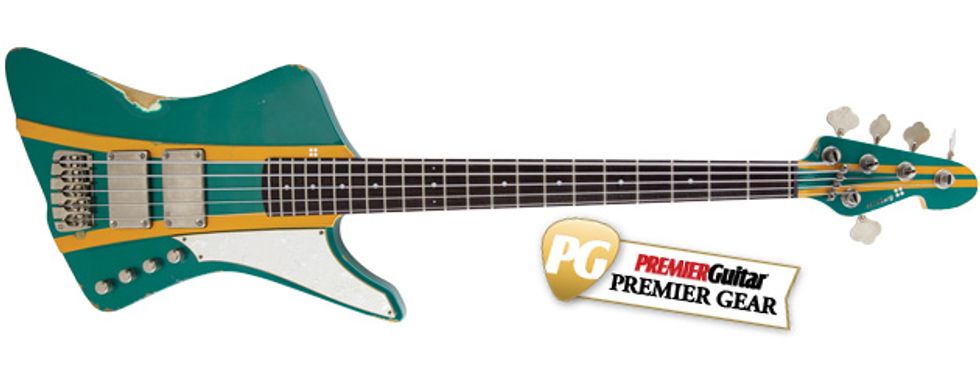Clip 1 - Passive mode. Tone dial at 60 percent. Ciff goes through three pickup configurations in this order (neck, blended, bridge).
Clip 2 - Active mode. Bass and treble boosted. Slap passage goes through three pickup configurations in this order (neck, blended, bridge).
Back in the late ’50s and early ’60s, Gibson challenged tradition by introducing a number of futuristic-looking instruments, including the Explorer and the Thunderbird. While their shapes may not have been immediately favorable to the masses, the Explorer and Thunderbird have long since solidified their place in rock lore. Inspired by these classic templates—but also motivated to tweak some of their commonly cited shortcomings—Holger Stonjek of Sandberg Guitars and Chicago Music Exchange’s Marc Najjar put their heads together to dream up the Sandberg Forty Eight bass. It’s an instrument that boasts aggressive styling with modern technology, tonal versatility, and a boatload of wow factor.
Flying a New Bird
The Forty Eight’s looks combine the curvaceous corners of a Thunderbird with the angularity of an Explorer. The body of our test bass was constructed from alder (ash is used for matte-finished models), and a neck carved from Canadian hard-rock maple that’s topped with a rich, rosewood fretboard is bolted on.
The gorgeous teal-metallic finish with gold racing stripes pairs well with the assertive body shape and invokes memories of Speed Racer vehicles. Our tester was made extra sporty with the cool, matching headstock option as well as the “hardcore-aged” relicing that gives the instrument character without forcing a vintage vibe. In short, the Forty Eight looks pretty badass.
What really sets the Forty Eight apart is Sandberg’s electronics and hardware package. A Sandberg V-style split-coil pickup rests in the neck position for full, warm tones, while one of the company’s Powerhumbuckers resides in the bridge slot for delivering bark and bite. The pickups are dressed with aged-metal pickup covers that contribute nicely to the vibe. Tone shaping is provided by Sandberg’s 2-band active preamp, which can be disabled for passive operation via the push/pull volume knob. And to complete the package is Sandberg’s proprietary hardware, which provides pinpoint accuracy for intonation adjustments, string stability, and overall playability.
deeper characteristics.
Go, Forty Eight. Go!
Historically, critics of Thunderbird basses have cited balance issues and cumbersomeness. Sandberg was no doubt savvy to this, since the Forty Eight held its position in most playing angles when strapped and standing. Not only that—the Forty Eight’s balance held up in a seated orientation as well.
The Forty Eight’s fast neck provided effortless shifting and string crossing, and the satin finish felt smooth against my thumb. As someone who usually plays 34"-scale instruments, I found the optional 35" scale of our test bass to be quite manageable. (The standard scale length for the Forty Eight is 34".) Never did it feel like I had to reach for the lower notes of the fretboard. My only concern with the design was in the upper portion of the fretboard, where the deep neck joint prevented my hand from reaching the upper three frets of each string. Yes, it’s the nature of the beast with this body style, but at a price a touch north of 3K, I’d love to have easy access to all of the notes.
Another not-uncommon gripe with some Thunderbird-style basses is the 3-point bridge, known for providing some challenges when setting up string height. I appreciate that the Forty Eight has been outfitted with Sandberg’s standard bridge, where the string height can be adjusted at each saddle. These saddles also allow shifts in string spacing and easy adjustments to intonation, and the locking mechanisms for each saddle are a nice touch as well.
Forty Eight Bottles of Tone
I did not expect the Forty Eight to be so sonically versatile. Basses of this style are known for having—dare I say—thunderous tone, but the Sandberg pickups and electronics made it much more than a one-trick pony.
To start out, I plugged the Forty Eight into a Bergantino B|Amp paired with a Bergantino HD112 cabinet, and pulled up the volume control to set the bass in passive mode and reveal the true characteristics of the instrument. The neck pickup on its own produced lush, thick mids accompanied by lows that were supportive rather than overpowering. And the impressive 5th string felt solid while it delivered bowel-shaking notes with heft and bell-like clarity.
Ratings
Pros:
Superb looks, playability, and tonal versatility.
Cons:
Difficult to reach upper regions of the fretboard. Pricey.
Tones:
Playability:
Build/Design:
Value:
Street:
$3,035 (as equipped)
Sandberg Forty Eight
sandberg-guitars.com
Soloing the bridge pickup delivered tight, bark-y mids that would even pleasantly surprise Jaco disciples, and balancing both pickups created a focused, scooped sound, with a top-end bite that would fit nicely in most modern musical styles. The responsive tone knob added to the palette by topping my sound with clang and bite, or tempering the highs for brooding, deeper characteristics.
Ear-pleasing tones summed up my live experience with the Sandberg Forty Eight as well. Gigging with a blues-rock trio at a medium-sized club, I expanded my rig by adding a Bergantino HD210 to the B|Amp/HD112 setup. When I soloed the neck pickup and slightly boosted the lows for a jam of Albert King’s “Killing Floor” and “Born Under a Bad Sign,” the tone was big and warm, and it established a thick foundation that proudly held its own within the loud ensemble.
Balancing both pickups in active mode and boosting the highs and lows created a smoking modern slap tone that punched the low notes and projected the popped strings with a pleasant edge—perfect for a contemporary approach to Bobby Caldwell’s “What You Won’t Do for Love.” And when soloing the bridge pickup for tunes like Steve Wonder’s “Superstitious,” the Forty Eight shined by barking hard and giving my 5th-string notes a snarling intensity. I can report that at the end of the night, both listeners and bandmates lauded the extreme looks and tonal versatility of Sandberg’s newest creation.
The Verdict
The Forty Eight is simply a great-looking bass with tones that will suit most musical situations. The Powerbucker and split-coil pickups provide a wide palette of timbres, all the way from clean and contemporary to dark and dirty. With its excellent balance, playability, and high-end hardware, Sandberg’s hybrid design essentially eliminates the issues of the models that influenced it. The Forty Eight’s price tag places the instrument in a range that typically caters to financially comfortable players, but it’s hands down one of the best Thunderbird- or Explorer-style offerings I’ve had my hands on. Sandberg already had a solid reputation for improving on tradition, and the Forty Eight confirms it’s well deserved.







![Rig Rundown: AFI [2025]](https://www.premierguitar.com/media-library/youtube.jpg?id=62064741&width=1245&height=700&quality=70&coordinates=0%2C0%2C0%2C0)












 Shop Scott's Rig
Shop Scott's Rig















































